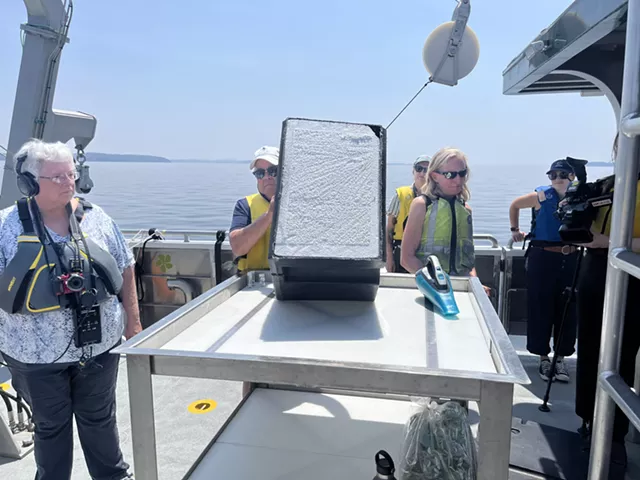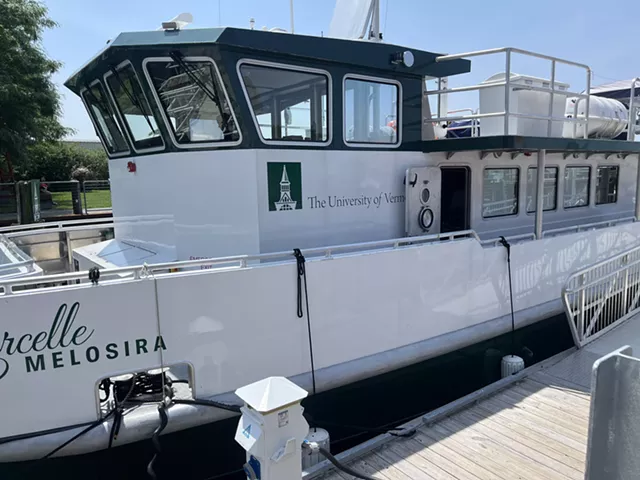Aboard the ship, scientists, environmentalists and activists from six different organizations showed reporters different forms of plastic waste, including fragments, fibers, foam and something called “nurdles.”
Nurdles are preproduction plastic beads that are melted and molded to create other plastic products. Plants in Vermont and New York mold plastic using the beads — and some have made their way into the lake. It isn’t quite clear how, but researchers said they could be spilled in shipping mishaps or through factory dumping.
If no one removes the larger plastics soon, they will continue breaking down in the environment, becoming smaller and smaller before making their way into wildlife, humans and even the air. A 2019 study by the University of Victoria in Canada found “Americans consume more than 70,000 microplastic particles every year from the food they eat, the water they drink, and the air they breathe.”
Researchers have even found rubber nurdles that were under a millimeter in size. They all look the same under a microscope, which led researchers to believe they are preproduction materials instead of bits of tire, which are also sometimes found in the water.
“The Lake Champlain Basin is over 8,000 square miles, so there’s a lot of area for trash to be deposited,” UVM research interns Molly Moening and Erika Talley told members of the press during the July 16 event. “It could be on the top of Mount Mansfield, and you drop a piece of plastic, and it ends up in Lake Champlain.”
Lakekeeper Julie Silverman Is a Watchdog for Lake Champlain

Lakekeeper Julie Silverman Is a Watchdog for Lake Champlain
By Mary Ann Lickteig
Environment
The Lake Champlain Basin Marine Debris Coalition has started collecting data to try and understand what kind of plastics end up in the lake. They’ve launched a “debris tracker” app where citizens can report the kinds of washed-up junk they find. It’s important data for scientists to understand where pollutants are coming from so they can make policy suggestions.
One major pollutant comes from the chunks of uncontained styrofoam that keeps docks afloat. The pieces can break off and become smaller and smaller until they’re nearly impossible to remove.
One solution is encasing the foam in more plastic. That might seem counterintuitive, but sealing the foam prevents it from crumbling and entering the waterways. Another option is to use air-filled flotation devices for docks.
Vermont’s Flood Safety Act, passed in 2024, bans the sale and repair of uncontained styrofoam docks.
“It’s the older camps, I think, and the older docks,” said Mike O’Brien, president of the Vermont Boat and Marine Association. He’s been doing outreach to landowners around the lake and its tributaries to make people aware of the pollution potential from foam dock materials.
Foam is the most abundant pollutant in Lake Champlain, according to the researchers, who listed some of the sources: buoys, packaging materials, take-out containers and coolers. Some 2.3 million tons of polystyrene foam end up in landfills every year, with only 1 percent or less actually recycled.
Flooding hasn’t helped things, either.
“We get these big erosion events with trees fanning in the river … I’m talking drift-trees. And when those drift-trees hit a dock… if it has fragile foam as its flotation, that also gets ripped off and enters our waterway,” said Julie Silverman, the Conservation Law Foundation’s Lake Champlain Lakekeeper.
Silverman says oil corporations are to blame for the prevalence of plastic, which is often used even when other options are just as inexpensive.
“This is like Plan B for big oil. The more we get engaged in alternative energy sources, the more big oil has been looking for ways for more plastic, to have a pipeline for their product,” Silverman said.
According to Silverman, legislation works. Since Vermont’s 2020 single-use plastics ban, which eliminated styrofoam take-out containers and plastic bags, researchers have found less of those items in the lake. They hope the dock foam legislation will do the same.


